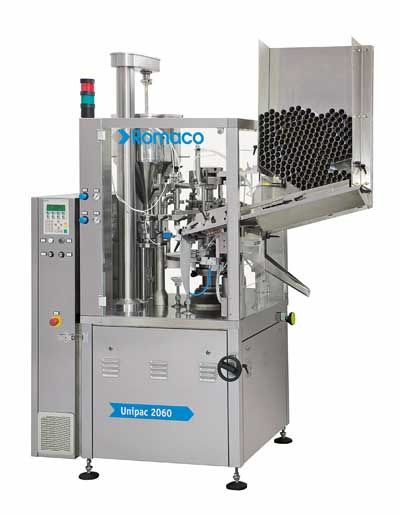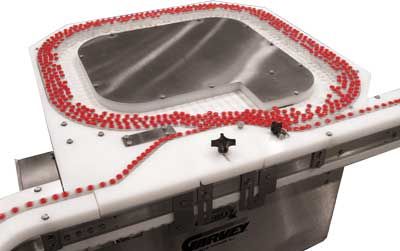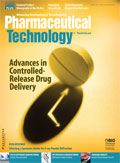Packaging Innovations Abound
New packaging concepts and equipment, including systems for vial handling, printing and labeling, and parenteral packaging, were revealed at INTERPHEX 2014.
INTERPHEX, the annual pharmaceutical trade show, always presents a wide array of packaging innovations. The 2014 show (held March 17-19 in New York City) did not disappoint showgoers looking for packaging concepts and equipment.
Contract packager Reed-Lane exhibited blister-packed Mucinex Allergy Tablets packaged for Reckitt Benkiser on its enhanced UPS4 MT blister line from Uhlmann Packaging Systems. The line, the first of two to be installed at Reed-Lane, operates at speeds of up to 600 blisters per minute and features a dedicated Aylward product feeder, an Uhlmann VisioTec vision system, and an in-line Uhlmann cartoner. Reed-Lane also offers bottling, pouching, and convenience vial-filling services.
A modular, automatic tube-filling and closing machine, the 2060 Unipac Tube Filling System from Romaco NA (see Figure 1), offers high-speed, single-nozzle filling on a 12-station turret. An integrated, high-capacity tube loader requires no changeover and is accessible from either side of the machine. A hot-air group with separate movements handles special-shape closures and minimizes the size of the closing area. Features include an easy-to-replace upper head; quick size changeover; lightweight, easy-to-disassemble dosing pump; and (optionally) servo-driven dosing pump and diving nozzle. The machine can be configured to seal aluminum or polyethylene laminate tubes.

The stainless steel Model 126 Trotter W labeler from NJM Packaging applies wraparound labels to cylindrical containers, including spray cans ranging from 1 to 8 in. (25 to 203 mm) in height and 0.5 to 4 in. (12.7 to 101 mm) in diameter. If needed, the maximum diameter can be extended to 5 in. (127 mm). Dedicating the system to wrap labeling of round containers simplifies the machine and shrinks its footprint to only 4 x 10 ft. (1.2 x 3 m), with or without an optional reject system. A servo-driven label dispenser combines consistent application with low maintenance. Elimination of change parts and tools cuts changeover time to less than 15 minutes. The standard Trotter W model features a friction wheel infeed capable of moving up to 120 containers per minute (cpm). With an optional starwheel infeed and motorized rewind, the labeler achieves speeds up to 150 cpm. The addition of an optional thermal-transfer printer and vision inspection system support e-pedigree serialization. An Allen-Bradley MicroLogix 1400 programmable controller from Rockwell Automation controls machine functions. Software embedded in the Allen-Bradley Panel View Component C600 human-machine interface allows functions to be added by plugging in a laptop. Off-the-shelf components simplify maintenance and reduce the need to inventory spare parts.
Vial handling
A vial drying system from Garvey cuts drying time from hours to minutes for vials arriving from cold storage. Based on the company’s Infinity RX accumulator, the system dries up to 800 vials per minute. “Vials are dry and at room temperature at the end of the conveyor,” said Robert Beamer, media and marketing coordinator at Garvey, in an interview with Pharmaceutical Technology. A shuttle mechanism simplifies unloading trays of frozen vials onto the drying conveyor. Pressureless single-filing minimizes chances of damage and increases efficiency for feeding into a labeling or inspection system. The system can be configured for multiple lanes and to increase the number of passes over the drying zone.
Garvey also showed its RX 36 tabletop accumulator (see Figure 2). Designed to replace a rotary table or turntable accumulator, the RX 36 unit occupies the same 36-in. footprint, ensuring a simple retrofit, and is also available in a 48-in size. Symmetrical design permits infeed (tray unloading) and outfeed sections to be positioned on any side for maximum flexibility. Work with the glass industry and FDA’s Glass Handling Task Force confirms that the system unloads, single-files, and unscrambles vials without the pressures normally associated with rotary tables, reducing both the chance of damage and noise levels, the company reports.

Printing and labeling
The Videojet 8610 thermal inkjet from Videojet prints nonporous substrates like coated paperboard, blisters, film, and foil with fast-drying, solvent-based inks. The key is a patented ink cartridge designed to jet MEK-based inks. “Formerly, you had to have a knock-out area for water-based thermal inkjets,” said Jim Kerper, North American sales manager for the Systems Solution Group at Videojet Technology, in an interview with Pharmaceutical Technology. A shutter-based mechanism controls the printhead, which prints at a resolution of 240 x 240 dots per inch at speeds of up to 102 m/min (333 ft/min). Character height with a single printhead is 12.7 mm (0.5 in), but up to two printheads can be ganged. Higher print quality on the nonporous surfaces aids the inspection process. In addition, the unit’s preset font packages help the vision system recognize the code (e.g., to distinguish “O” from zero or “B” from 8). The serialization-ready thermal inkjet prints alphanumeric characters, as well as linear and two-dimensional barcodes including QR codes and the GS1-compliant DataMatrix code specified in serialization requirements. The printer can be supplied with an installation- and operation-qualification validation package.
Another serialization-ready system consists of a print/apply labeler from Domino Amjet integrated with the Intelli-Pac Manual Case Aggregation System from Omega Design. The machine handles loose or bundled bottles and cartons. The process begins with placement of a case on a table or in a case former. A plunger-equipped printer/applicator applies a serialized label. One camera reads the case label and another captures the codes of each item in the case to establish a parent/child hierarchy. Configurable for manual or semiautomatic operation, the ergonomic system seamlessly integrates to layer-aggregation technology, case-label printer, operator touchscreen, data-management system, case-loading table, and handheld scanner. Other capabilities include unit-to-bundle data syncing, case-to-pallet data syncing, and case-forming and taping. Domino also offers equipment for applying serialized codes to primary containers.
Glass-free parenteral packaging
To eliminate problems sometimes encountered with glass packaging, Catalent introduced glass-free Advasept Technology, which the company uses to produce ultrapure polypropylene containers with a blow-fill-seal system. The technology eliminates surface delamination problems and reduces foreign particulates, protein surface interaction, and breakage. The polymer containers are also lighter weight than glass containers. Isolating the resin extrusion area and fill zone (ISO 5) minimizes exposure of the product and container to the environment. In addition, the boundary between aseptic and non-aseptic areas is sterilized in place, eliminating the need for aseptic connections. Containers can be customized for ophthalmic, respiratory, topical, and biotechnology products with easy-open twist-off or pop tops and multiple stopper designs. Sizes include 10, 50, and 100-mL containers.
Quality-control tools
An advanced quality-control (QC) tool bundle from Global Vision inspects text, artwork, spelling, Braille, and barcodes and provides annotation functionality. Web-based software deploys on an on-premise or private cloud server and provides enterprise-wide access to packaging QC tools. “Proofware gives any enterprise instant access to everyone involved in the security of their brand copy and artwork throughout the enterprise,” explained Reuben Malz, president of Global Vision in a press release. “With Proofware, a new level of collaboration is achieved between different teams within the organization, their customers, and suppliers” (1). Other features include report management tools to organize inspection reports and easy integration with artwork, document, and product-lifecycle management solutions. Software permits multiple inspections to be run with the same set of files. Proofware also supports e-signature, call-outs, stamps, measurement, and color inspection.
A handheld Humicap HM40 humidity and temperature meter from Vaisala simplifies spot checking, records measurements, presents data in a variety of configurations, and enables calibration of fixed-mount transmitters in the field. The sensing probe is mounted on the portable unit but also can be removed and attached to the end of a wand. A graphical display indicates that a measurement has stabilized. The unit can be calibrated by Vaisala or in-house.
Sorbents
Multisorb’s Calculations through Operation program protects product stability using optimized sorbent formulations, which are dropped or fit into the package or mixed with the resin of the container, closure, or other component. The program also includes dispensing equipment for the selected sorbent such as the APA-2000 high-speed dispenser with a bottling-line interface or the APA-500 low-speed, semiautomatic dispenser. With multiple models to choose from, dispensers can be matched to line speed and interface requirements. Options include splicing cabinets and gas or dry-air purge systems.
Reference
1. Global Vision, “Global Vision Releases Proofware, the First All-in-One, Cloud-Based, Packaging Inspection Suite,” Press Release (Montreal, Feb. 11, 2014).

About the Author
Hallie Forcinio is
Pharmaceutical Technology's
Packing Forum editor, 4708 Morningside Drive, Cleveland, OH 44109, tel. 216.351.5824, fax. 216.351.5684, editorhal@cs.com.

Pharmaceutical Tariffs Are Imminent: How Industry is Bracing for Impact
April 16th 2025On April 14, 2025, the Trump Administration launched a national security-driven investigation into pharmaceuticals, a move that will likely result in tariffs being placed on pharmaceutical drugs, ingredients, and other components that are imported from outside of the United States.
Drug Solutions Podcast: A Closer Look at mRNA in Oncology and Vaccines
April 30th 2024In this episode fo the Drug Solutions Podcast, etherna’s vice-president of Technology and Innovation, Stefaan De Koker, discusses the merits and challenges of using mRNA as the foundation for therapeutics in oncology as well as for vaccines.